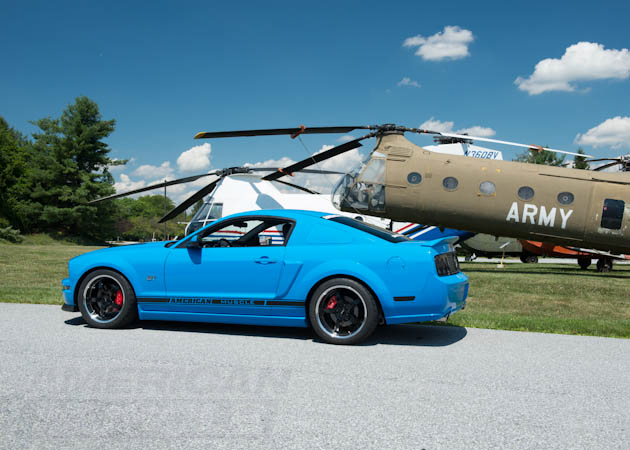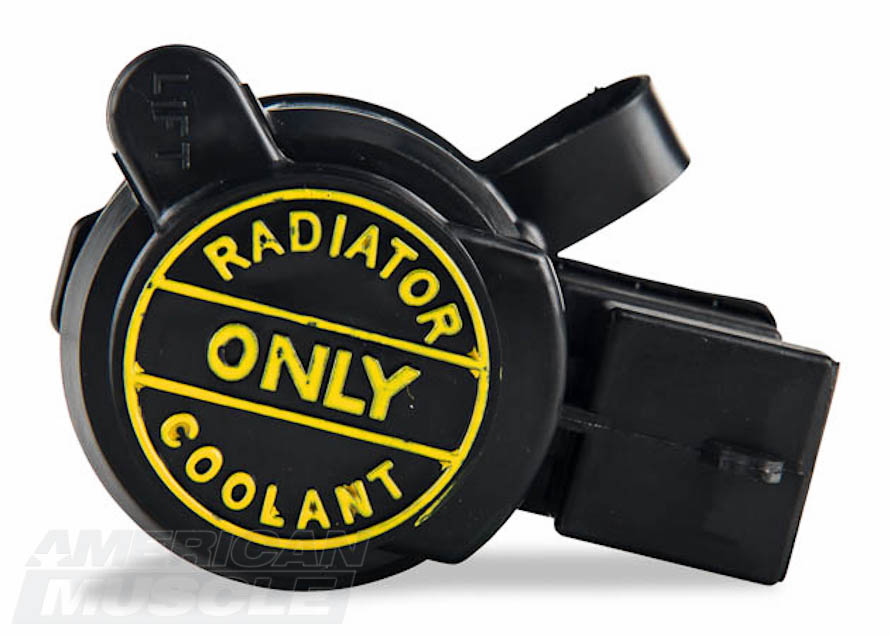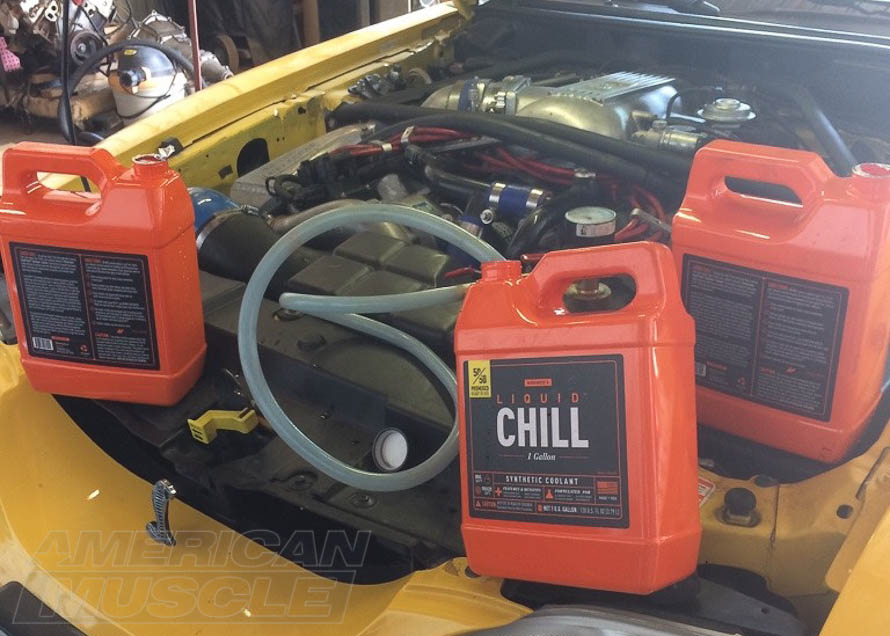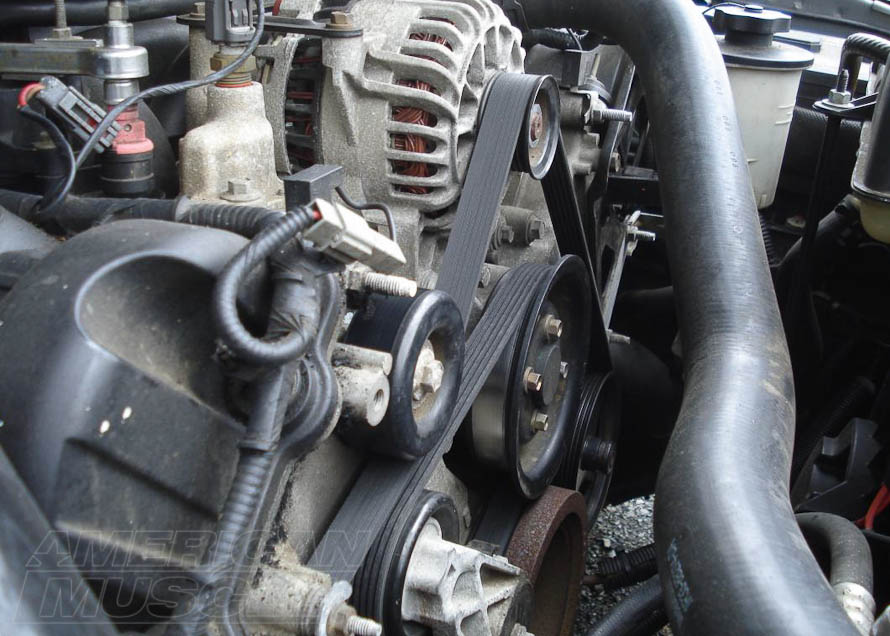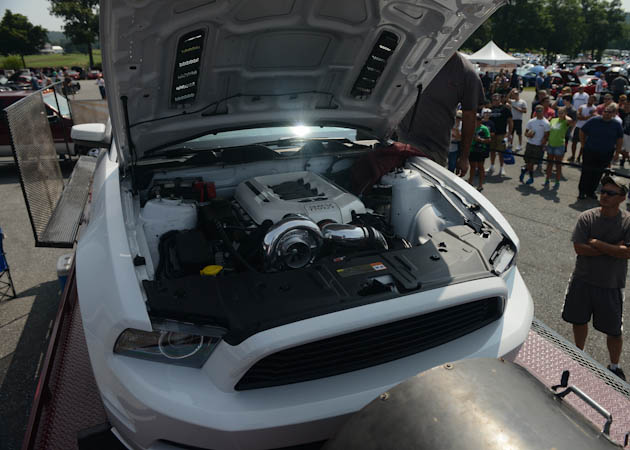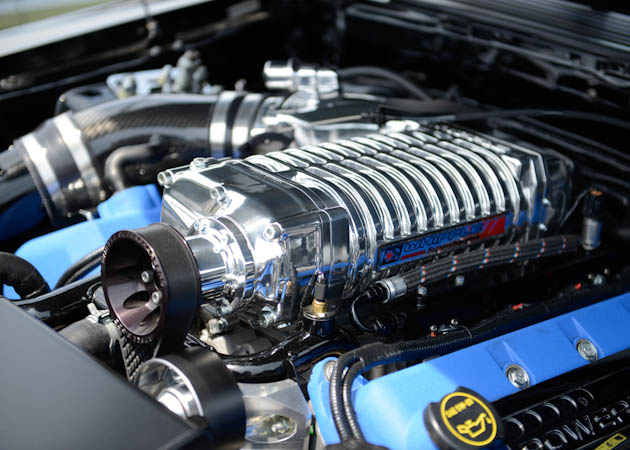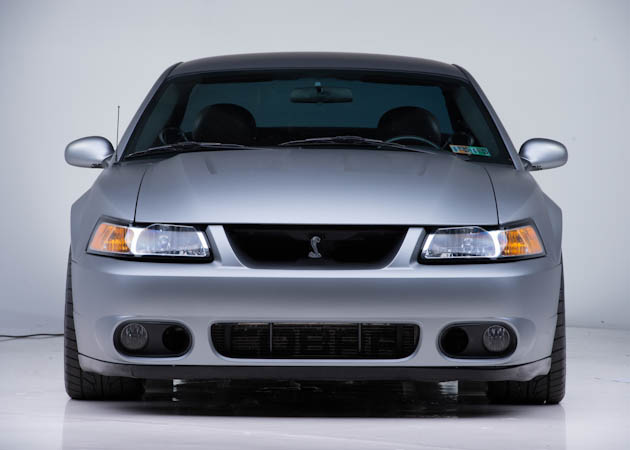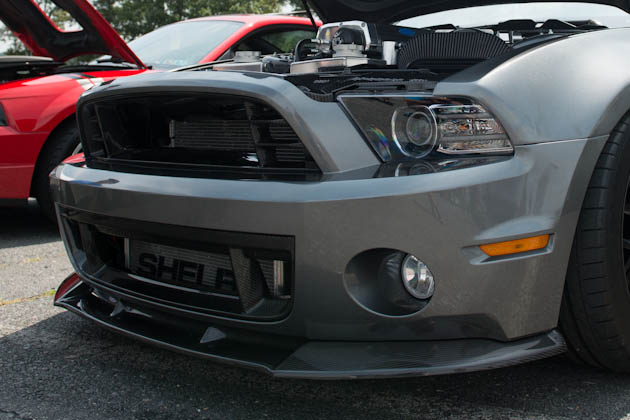How Does a Mustang's Cooling System Operate?
The coolant flows out of the radiator outlet near the bottom of the radiator and is pushed into the motor by the water pump. The coolant then travels through the block and up through the heads on its way toward the water outlet. Just behind the water outlet on most motors resides the thermostat. The thermostat regulates the flow of water, restricting the flow to the radiator until the water temperature reaches the point where it is fully open. Once fully open the hot coolant flows out of the motor to the inlet near the top of the radiator. The coolant then passes through the tubes of the radiator where it gives up heat to the passing airflow.
Your engine works just like a big air pump. Air comes in, fuel is added, and the mixture is ignited. The cooler the incoming air, the more dense it is which means you can add more fuel and make more power. Have you ever wondered why your car feels more powerful on cool fall days? That’s the reason why! Cooling is important on any engine, but it’s even more important on an engine with forced induction like your EcoBoost Mustang. When air is compressed, it heats up. Since the turbocharger is compressing the air to squeeze more into the engine, the post compressor air can be a lot hotter than the ambient air temperature. On a stock car this can cause a noticeable loss in power on warm days. When you tune the car and crank up the boost, the intake temperatures can get even hotter.
Should I Use Water or Coolant?
On today's engines, cooling system maintenance is critical to the life of the engine. With the variety of metals used in your Mustang's motor, there has to be something besides the water in the cooling system to protect those metals from corrosion. There are a variety of different coolant formulas in a variety of colors in use by automakers, all with specific metal protection factors. It's not like the old days when you just grab the good old green stuff off the parts store shelf. Run the wrong coolant in your motor and you take the chance of damaging corrosion taking place.
What Coolant Should I Buy?
The best coolants to buy to maximize the cooling system efficiency and protection are the premixed ones with deionized water. You should never use tap water in your engine's cooling system, only deionized water. Deionized water has been purified of contaminants and the mineral elements have been filtered out, minimizing deposits that may collect in the cooling system that can block critical water passages in the motor or the cooling tubes of the radiator.
What is a Water Pump and What Does it Do?
Given the name of the piece in question, water pump, it’s easy to speculate on its use. If you’re thinking “the water pump pumps water”, you pretty much hit the nail on the head. To drive the nail all the way in, the water pump circulates coolant throughout the engine. Coolant is a mix of water and anti-freeze (usually a 50-50 mix). Anti-freeze is used to increase the boiling point of the water, to lower the freezing point and also to inhibit rust as the solution circulates through the engines passageways. Otherwise as the engine heats up, the water could very easily boil off, resulting in the engine overheating. In colder climates the water could freeze which could potentially crack the block. Thus anti-freeze is used to negate these effects.
To summarize, a water pump pumps coolant throughout your Mustangs engine, and the job of the coolant is to cool the engine, by drawing heat away as it passes through the many chambers. The water pump is an integral part of any liquid cooled internal combustion engine, as without it, the engine will quickly overheat and seize. Thus it is very important your water pump be in good working condition.
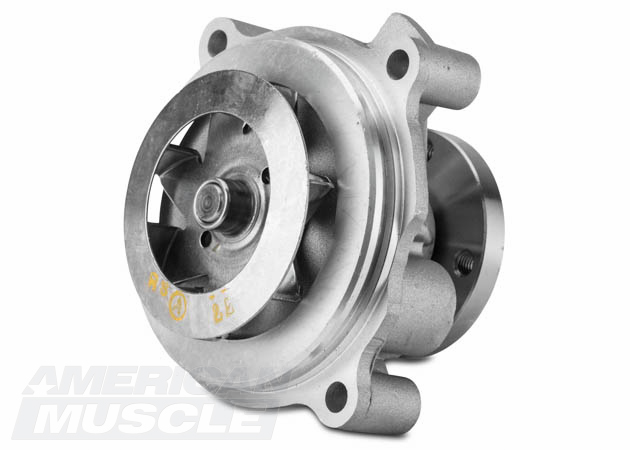
1999-2004 Water Pump
How Does the Water Pump Work?
In the case of our ‘Stangs the water pump is a mechanical design, driven via the accessory belt, right on the front of the engine. The accessory belt runs over the water belt pulley, which in turn is connected to the pump vanes inside of the water pump housing. From the moment you start the engine to the moment you turn it off, the water pump is spinning continuously. It draws coolant from the radiator and circulates it through the cooling system into the intake manifold, block, and heater core before returning to the radiator where the incoming air draws the heat out of the coolant and into the ambient atmosphere.
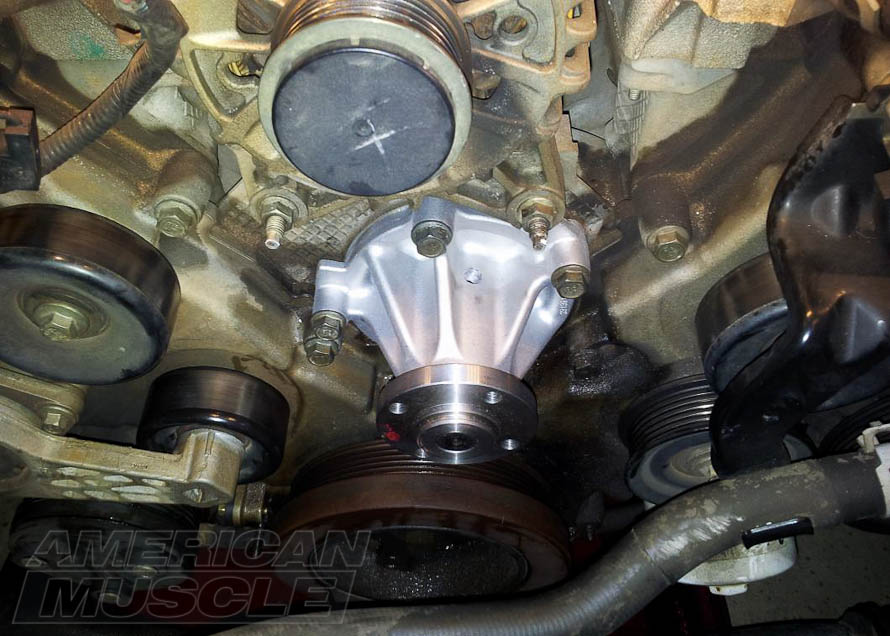
1996-2001 and 2005-2009 4.6L Water Pump
How do I Verify My Water Pump is Functioning Properly?
As previously mentioned, the water pump is an integral part to any internal combustion engine. If it fails, your engine can quickly overheat, causing major damage. For the most part, water pumps are very reliable and last many years. However, like any part, they can wear out. Luckily, there are some very easy tests we can do to check the health of our water pump.
First, with the engine off, reach down to the water pump pulley, and gently push the pulley up and down. There shouldn’t be any play or wobble. If there is, that pump is wearing out. As the pump is driven by the belt, check that the accessory belt is in good shape too. If it is cracking, replace the belt. If the belt were to break while you were driving, although the water pump did not fail itself, it would stop cooling the engine.
Secondly, grab a flashlight and look up at the water pump from underneath the car. Every water pump comes with what is called a “weep hole”. This hole is located at the bottom of the pump, and is a great health indicator. If coolant is dripping out of the hole, or there are stains around the hole, it is evidence the pump is wearing out. The weep hole is engineered solely for this purpose.
A final check you can do is to check the circulation. With the engine on and up to regular operating temperature, grab a towel and pinch the upper radiator hose. When you let it go, you should feel a surge of coolant passing through, letting you know coolant is circulating through your system.
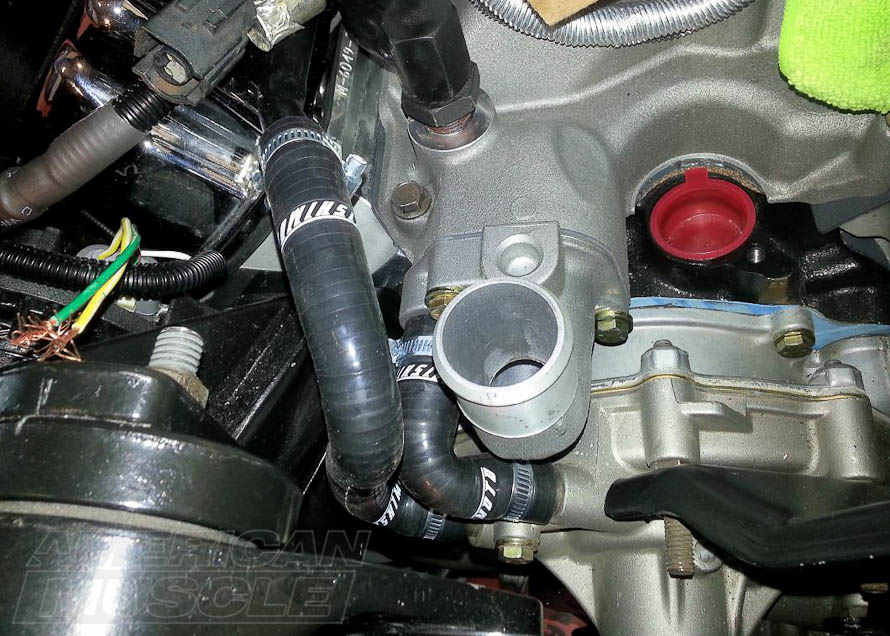
Silicone Radiator Hoses for 1986-1993 Mustangs
NewArrivals
My Water Pump is Faulty. What do I do?
If your water pump has failed any of the tests above, it is time to replace it. The great thing is, it isn’t very hard given the location of the pump on the front of the engine. A determined do-it-yourselfer can get it done in an afternoon with basic hand tools, with plenty of time to spare before the game starts.
Replacing the Water Pump - the Factory Opinion
If you use your Mustang strictly as a daily driver to get from point A to point B then a factory replacement unit will be just fine. The stock water pump does a decent job keeping the coolant is motion on a stock or close to stock build. Another advantage of going with an OEM product is the cost will be fairly cheaper than the other options. They will cool your engine with no issue if you are just running a few bolt-on upgrades, and they are also more readily available and can be picked up at various local auto parts stores.
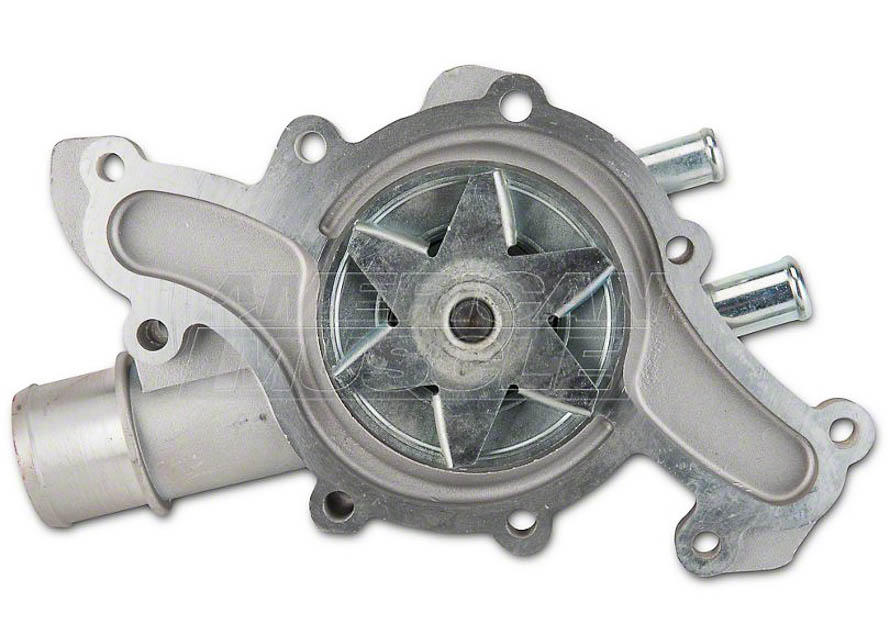
1994-1995 5.0L Replacement Water Pump
High Flow Aftermarket Mustang Water Pumps
If you decided you wanted a little more horsepower and have completed, say, a head and cam upgrade, went with a stroker kit, or you are running a very stout bolt-on car then a high flow water pump may be a better choice for you. High flow water pumps have redesigned impellers which allow it to cool the engine more efficiently. These products offer an increase in flow while reducing the amount of power needed for the water pump to operate.
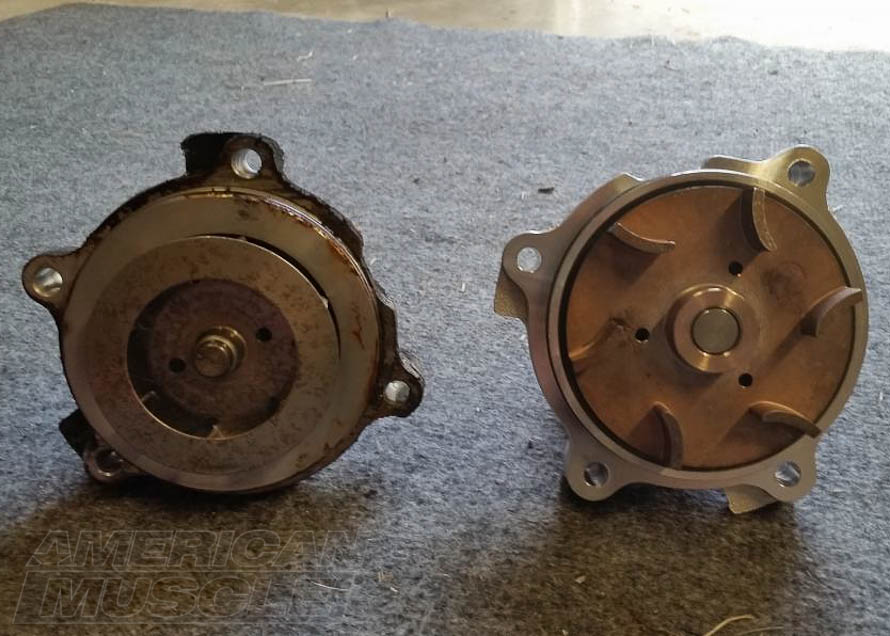
High Flow Performance Pumo (right) vs. Stock (left)
Electric Mustang Water Pumps
Going with an electric water pump would be exactly what you are looking for if you mainly use your Mustang for racing. Some Mustang enthusiasts use them on daily driven cars but they are far more commonly seen on race cars because of the advantages. Electric water pumps are also the most expensive compared to the other choices so they may not be the best option on a budget build.
There are two main benefits of choosing an electric unit over an engine powered water pump. This first is they don’t drain engine power as they are not belt-driven. This gives electric water pumps their second advantage of being able to be turned on when the car is off, helping cool your Mustang between runs. Electric water pumps have different flow rates so make sure you select one that will efficiently cool your engine depending on your application. They are highly versatile and can also be controlled by a switch to maintain the desired temperate.
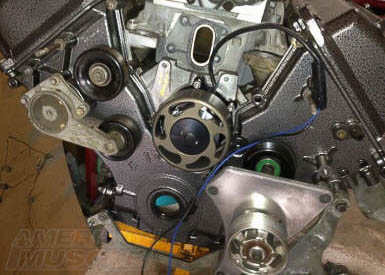
Electric Water Pump
2001 Mustangs: How to Identify the Water Pump Pulley
Mid-way through the production run for the 2001 model year Ford changed the design of the water pump on the 4.6L engine. The older style pump produced from 1996 to mid-2001 had a longer shaft. In January of 2001 the design of the pump was changed to a shorter shaft. This necessitated a change in the design of the pump pulley.
You should visually identify which pulley/pump you have before ordering a replacement. The old water pump pulley had a convex or "bowed-out" face. The new design has a concave or pressed in face. There is no exact changeover date for the pump and pulley. It is important to visually inspect your car to see which design you have. Supposedly the changeover occurred in January of 2001, but we have seen cars with identical January build dates and different water pumps and pulleys. We have also seen the old style pulley used in a few 2001 models, so be sure to check yours before ordering. Refer to the pictures below to see which pulley design you have and the right part number for your application.
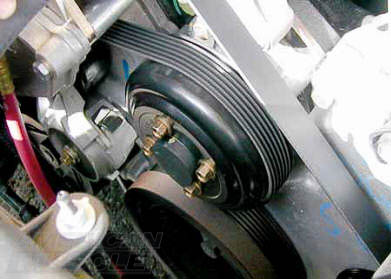
Early Style 1996-2001 Water Pump
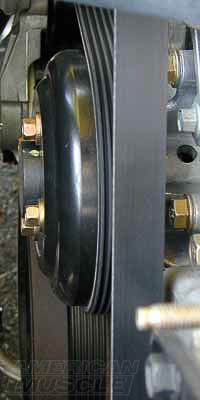
1996-2001 Late Style Water Pump
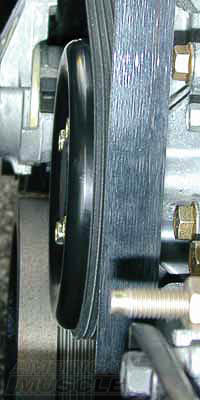
2001-2004 Late Style Water Pump
A Note About Reverse Flow Water Pumps
Reverse flow pumps were introduced at the same time of the release of the serpentine belt system. For mustangs, this year was 1979. The primary difference between reverse and regular flow pumps is simply the direction of flow and the flow of the pump itself.
Should I Run an Aluminum Radiator in My Mustang?
Radiators or, more technically correct, heat exchangers take the excess heat away from the engine and release this heat to the air. For the most part, radiators in today's cars are made with an aluminum core with composite tanks. These radiators are lighter, stronger, and more efficient than the copper brass radiators once used. They are also a good deal less expensive to produce. A few cars use all aluminum radiators and most aftermarket performance radiators are also made entirely of aluminum. The other advantage to aluminum radiators is the aluminum dissipates heat so well, the radiator cores can be smaller, yet still offer the cooling capacity of larger copper brass units. Another advantage to aluminum is that it is very easily recycled, an ever growing concern in today’s world. One disadvantage is that aluminum corrodes very easily so proper coolant mixtures are critical.
One other thing to take into account when purchasing a radiator is transmission type. A radiator intended for a manual transmission usually differs slightly from that intended for an automatic car because of the extra transmission cooler needed for the automatic transmission. Some radiators are universal, but not all, so just keep that in mind.
Now, one drawback to aluminum is that it can be somewhat brittle. Road vibration and bumps can stress the radiator and cause it to crack and then leak. This is why it is very important to purchase a quality radiator with quality welds. A poorly made radiator will let you know sooner rather than later, sometimes leaking right out of the factory!
Advantages:
- Lighter, stronger and more efficient
- Lower cost
- Better heat disbursement
- Larger cooling capacity
- Easily recycled
Disadvantages:
- Easily corroded (another reason to use the proper coolant!)
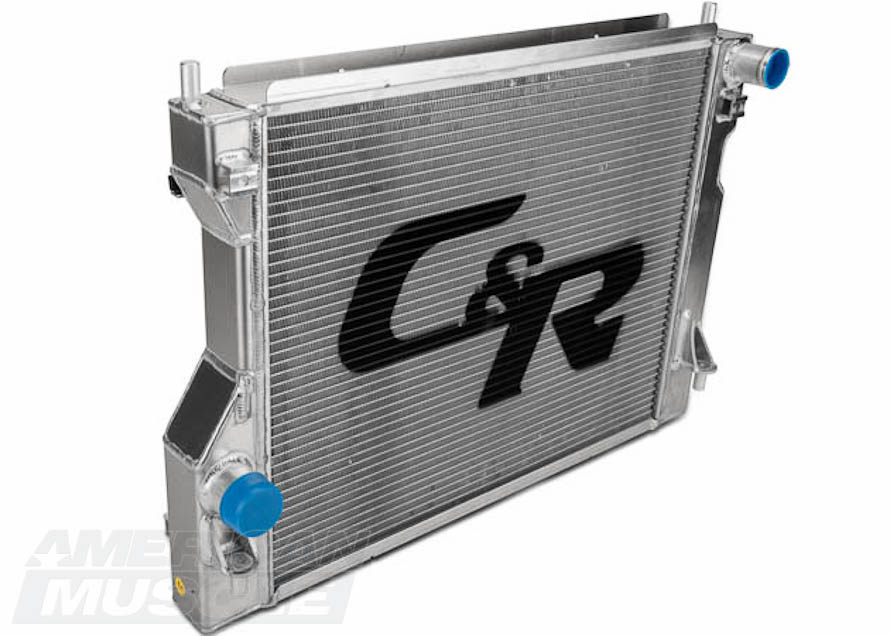
Aluminum Radiator
How Effective are Aftermarket Radiators?
Engines produce a ton of energy which means heat is an issue. This issue is tackled with a water type cooling system. In these systems, radiators are used to cool the water off as it cycles through the system.
When looking to boost an engine's power output, the radiator will have a harder time cooling the water within and then it’s time to look toward an aftermarket unit. With aftermarket radiators, one can go too far and lower the temp a bit too much meaning they are ineffective. The trick is not to go too far.
Many aftermarket companies use percentages to show how much more efficient their radiator is in comparison to the stock unit. The trick is to stay within bounds. If the engine is mildly modified but is having cooling issues because of the factory unit, you don’t have to drop in something way over the top. Just something that is a mild step up.
When Does My Mustang Need Better Cooling?
Generally, for basic modifications a stock cooling system is substantially adequate. They perform quite well and last a long time. However, if an engine is being custom built or having a supercharger/turbocharger installed, it might be a good idea to upgrade the radiator and water pump. Utilizing something such as an aluminum radiator does a solid job of dissipating heat and keeping operating temperatures at a respectable level.
For a daily driver, it will hardly be necessary. For a racing application however, cooler temperatures never hurt to attain when highly modified. If you plan on doing some heavy road racing, looking into a differential cooler could be a solid idea. They generate some heat and while normally not an issue, over prolonged periods of high rpm it can get hot.
Stock Mustang Thermostat Temps and Fan On/Off Temps
| Mustang Gen |
Thermostat Temp |
Fan On/Off |
| Foxbody (1979-1993) |
190 |
- |
| SN95 (1994-1998) |
180 |
221/-220 |
| S197 (2005-2014) |
180 |
228/-216 |
| S550 (2015-2019) |
180 |
228/-216 |
What is an Intercooler?
An intercooler is basically a radiator or heat exchanger. It is usually located on the front of the car in front of the engine’s radiator. When the intake charge from the turbo travels through the intercooler (air to water type), the heat of the intake charge is dissipated through the cooling fins. This results in a cooler, denser intake charge.
Types of Intercoolers:
- Air-to-air: mounts before the throttle body, good for turbos and centrifugals
- Pros and cons: Reliable, but not as efficient as air-to-water
- Air-to-water: utilizes the engine’s coolant to cool the intake charge, good for top mount superchargers
- Pros and cons: can bring temps below ambient air temps, but for daily street machines heat soak is possible
Air-to-Air Intercoolers
There are two types of intercoolers out there, air-to-air and air-to-water. In an air-to-air intercooler, the intake charge itself travels through the intercooler and then enters the intake plenum through the throttle body. As the air is forced through the intercooler, the heat is dissipated via the fins of the intercooler. They are generally used on turbocharged and centrifugal supercharged applications.
Air-to-Water Intercoolers
An air-to-water intercooler works much like the engine’s radiator. Water circulated by a pump is circulated through the intercooler, effectively cooling the intake charge. Typically these are used on twin-screw and whipple type superchargers. There is a heat exchanger located in the intake plenum, under the supercharger. The water absorbs the heat from the intake charge, and carries this heat to the intercooler where it’s released. Cool water is then pumped back to the intake plenum.
Air-to-Water Pros and Cons
Since a whipple, or twin-screw style supercharger mounts directly to the top of the engine, the air-to-water set-up is about the only option available. Ford chose this type of intercooler for the Eaton supercharged ’03 Cobra, and it has proved to be very efficient. Many drag racers like this set-up because it allows them to run ice water through the intercooler. This will cool the intake charge lower than the ambient temperature outside.
On street applications, icing the intercooler coolant is not really an option. And after a while, the coolant becomes a bit warm. This causes heat soak in the supercharger. Although it won’t cause engine damage, it does result in a power loss. There is a noticeable difference in power and torque when the coolant hasn’t warmed up yet.
Pros:
- Very high efficiency
- Efficiency can be exaggerated by using ice, or other chemicals to produce lower temperatures
- Can be mounted anywhere along the charge pipe route.
Cons:
- Requires a water pump, a reservoir, a heat exchanger, et cetera
- Since it is more complex, it naturally causes more opportunities for problem, like leaks
- Can become heat-soaked when used for long period of hard driving
- Since it uses water, and additional components, this set-up weighs more
Air-to-Air Pros and Cons
The air-to-air intercooler has gained popularity due to its simplicity and reliability. There is no need for an external pump, and as long as the intercooler unit is in good working order, it functions without a hiccup. Many mustangs prefer this unit for street use because of the reliability factor.
The main drawback of the air-to-air intercooler is the limited cooling capability. Due to the fact it uses air to cool the intake charge, intake temps really don’t get any lower than the ambient temperatures outside. They’re also quite bulky, so they take up a little more room.
Pros:
- Requires no power to work
- Easier to set-up
- Requires no liquids to work and therefore, no chances for leaks
- Does not suffer from heat-soak as long as the intercooler is seeing sufficient air-flow
Cons:
- Efficiency is only as good as the ambient temperature
- Efficiency is only as good as the amount of airflow the intercooler is exposed to
- Cannot be mounted anywhere; must be mounting in an area that is exposed to high volumes of air flow
Are Intercoolers Needed for Boosted Mustangs?
Where are Intercoolers Installed?
Does the Size of the Intercooler System Matter?
Are Intercooling Systems Easy to Install?
Does My EcoBoost have an Intercooler?
Does an Intercooler Add Power?
Oil Coolers
What is the Ideal Operating Temperature for a Mustang's Motor Oil?
Should I Get an Aftermarket Oil Cooler for My Mustang?
Types of Mustang Oil Coolers
Facts About Performance Oil Coolers for Mustangs
Mustangs with Factory Oil Coolers
Fitment includes: 1979, 1980, 1981, 1982, 1983, 1984, 1985, 1986, 1987, 1988, 1989, 1990, 1991, 1992, 1993, 1994, 1995, 1996, 1997, 1998, 1999, 2000, 2001, 2002, 2003, 2004, 2005, 2006, 2007, 2008, 2009, 2010, 2011, 2012, 2013, 2014, 2015, 2016, 2017, 2018, 2019, GT, V6, Cobra, ShelbyGT500, Mach1, Bullitt, Boss, LX, SVO, EcoBoost, ShelbyGT350

